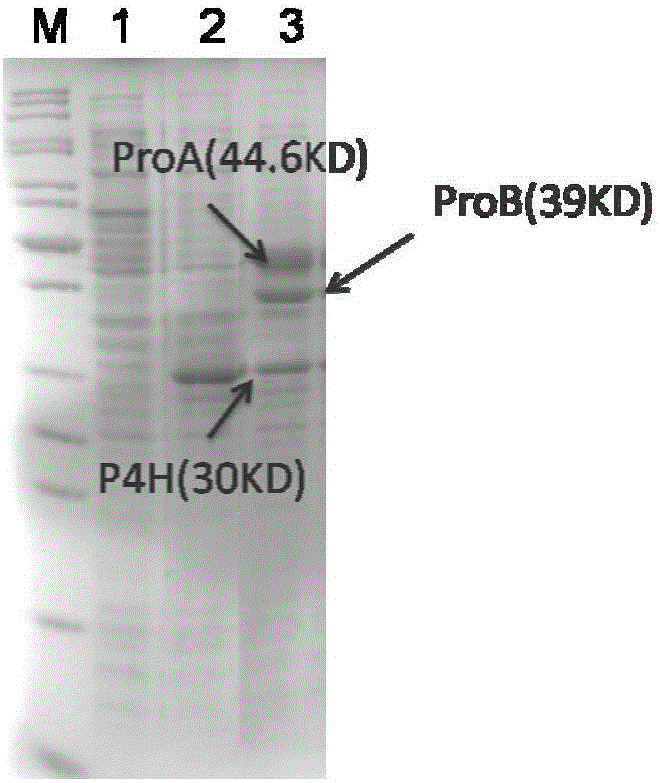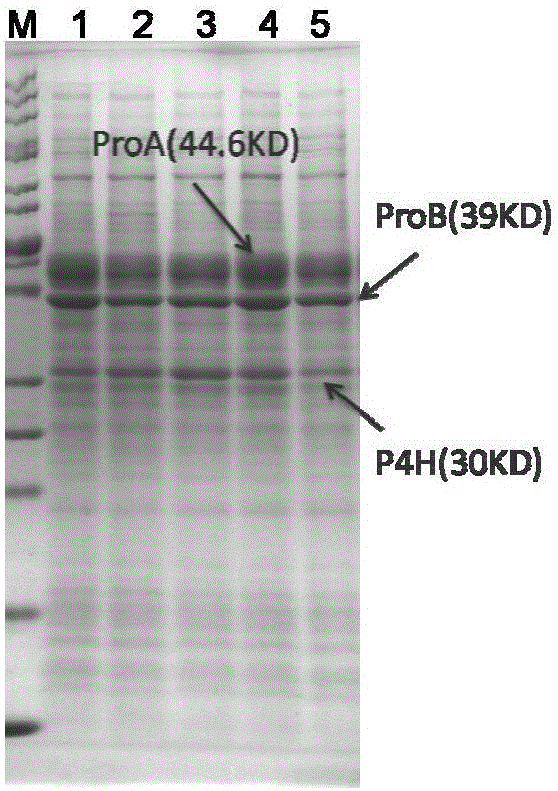Engineering bacteria for producing trans-4-hydroxy-L-proline and construction method and application thereof
A technology of proline and hydroxyl, applied in the field of producing trans-4-hydroxy-L-proline, can solve problems such as time-consuming, high cost and the like
- Summary
- Abstract
- Description
- Claims
- Application Information
AI Technical Summary
Problems solved by technology
Method used
Image
Examples
Embodiment 1
[0144] Embodiment 1, the preparation of recombinant cell
[0145] 1. Construction of recombinant vector pHBA
[0146] Construction of recombinant vectors expressing L-proline-4-hydroxylase (P4H), glutamate-5-kinase (ProB) and glutamate-5-semialdehyde dehydrogenase (ProA), the amino acid sequence of P4H As shown in SEQ ID No.1 in the sequence listing, P4H is encoded by the P4H gene shown in SEQ ID No.2, the amino acid sequence of ProB is shown in SEQ ID No.3 in the sequence listing, and the amino acid sequence of ProA is as shown in the sequence listing Shown in SEQ ID No.5, ProB is encoded by the ProB gene shown in the 12th-1115th nucleotide of SEQ ID No.4, and ProA is shown in the 1127-2380th nucleotide of SEQ ID No.4 The ProA gene codes. The specific method is as follows:
[0147]Preparation of the vector called pYB1S: Use P15ASal I_F: GTCGACGTGCGTCAGCAGAATATGTG and StrSphI_R: ACCTACCAAGGCAACGCTAT as primers, and vector pACYCDuet-1 (Novagen Company) as a template to ampli...
Embodiment 2
[0168] Example 2, using the recombinant cells of Example 1 to prepare trans-4-hydroxyl-L-proline
[0169] Using the recombinant cells of Example 1 to prepare trans-4-hydroxyl-L-proline, the experiment was repeated three times, and the specific steps of each repeated experiment were as follows:
[0170] Pick a single colony of pHBA / BW from the plate and place it in LB medium, culture it at 37°C and 220rpm for 10 hours to obtain the pHBA / BW bacterial liquid; inoculate the pHBA / BW bacterial liquid in 5052 autoinduction culture according to the inoculation amount of 1%. culture medium at 30°C and 220rpm for 16h to obtain the pHBA / BW culture solution; centrifuge the pHBA / BW culture solution at 4°C and 4200rpm for 10min and discard the supernatant to obtain the pHBA / BW crude cell. The pHBA / BW crude cells were washed twice with an aqueous sodium chloride solution with a concentration of 0.85% by mass of sodium chloride, centrifuged at 4°C and 4200 rpm for 10 min each time, and the ce...
Embodiment 3
[0180] Example 3. Optimization of the Conditions for the Preparation of Trans-4-Hydroxy-L-Proline Using Recombinant Cells
[0181] 1. Effect of α-ketoglutarate (α-KG) on the yield of trans-4-hydroxy-L-proline
[0182] According to the method of using recombinant cells to prepare trans-4-hydroxyl-L-proline according to Example 2, pHBA / BW is replaced by pHBA / ΔputA, and the transformation solution is replaced by 0mMα-KG transformation solution (0mMα-KG The transformation solution is composed of ultrapure water and solute, and the solute and its concentration are 100mM Tris, 50mM sodium glutamate, 4mM FeSO 4 and 8mM vitamin C, adjust the pH to pH7.0 with hydrochloric acid), 5mMα-KG conversion solution (5mMα-KG conversion solution is composed of ultrapure water and solute, solute and its concentration are 5mMα-KG, 100mM Tris, 50mM glutamine Sodium Oxide, 4mM FeSO 4 and 8mM vitamin C, adjust the pH to pH7.0 with hydrochloric acid), 25mMα-KG conversion solution (25mMα-KG conversion...
PUM
 Login to View More
Login to View More Abstract
Description
Claims
Application Information
 Login to View More
Login to View More - Generate Ideas
- Intellectual Property
- Life Sciences
- Materials
- Tech Scout
- Unparalleled Data Quality
- Higher Quality Content
- 60% Fewer Hallucinations
Browse by: Latest US Patents, China's latest patents, Technical Efficacy Thesaurus, Application Domain, Technology Topic, Popular Technical Reports.
© 2025 PatSnap. All rights reserved.Legal|Privacy policy|Modern Slavery Act Transparency Statement|Sitemap|About US| Contact US: help@patsnap.com



